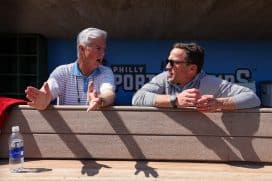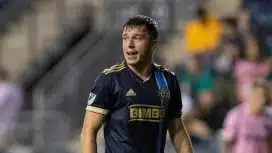Sixers
How Sam Hinkie set the Ground Work for Elton Brand to Build What Might be the Best Starting Five in the NBA
By Scott Cashin, Sports Talk Philly writer
This journey begins with the start of the Philadelphia 76ers' rebuild six years ago during the 2013 offseason. Shortly after former general manager Sam Hinkie first assumed control of the 76ers, he began a long-term process to build a team using the NBA Draft.
Hinkie dealt the team’s only All Star, Jrue Holiday, to the New Orleans Pelicans for their first-round selection in 2013 (used to select Nerlens Noel) and their 2014 first-round selection (which became the 10th pick used on Elfrid Payton).
While Hinkie addressed the media following his first draft, the Houston Rockets seized the opportunity to sign one of Hinkie’s targets. He later described missing out on signing Robert Covington as “heartbreaking”. He failed to lock in Covington as soon as the draft concluded and his subsequent delay left Houston an opening to ink Covington to a three-year contract.
With Covington under contract with the Rockets organization, Philadelphia had its sights set on the 2014 draft. Having already selected Joel Embiid with the 3rd pick, the 76ers exploited the infatuation that the Orlando Magic showed point guard Elfrid Payton from Louisiana-Lafayette by selecting him two picks before Orlando had a chance. This maneuver is not entirely uncommon in the NBA. If a team shows too much of their hand prior to the draft, another team can hijack the player and pry an asset away from the team in the process. This occurred most recently in the 2019 Rookie draft when draft veteran Danny Ainge and the Celtics snagged Matisse Thybulle with the 20th pick and forced Philadelphia to part with the 24th and an early second-round pick to in a trade to obtain his rights. As a side bonus to the additional compensation, players selected later in the first round cost less money over the term of their rookie deal when compared to earlier selections.
When Philadelphia was on the clock with the 10th pick in 2014 acquired via the Holiday trade, the Sixers general manager used the same approach on the Orlando Magic to leverage Payton for the 12th pick (Dario Šarić) and recoup a Philadelphia first-round pick owned by Orlando as a byproduct of the ill-advised Andrew Bynum trade. That pick eventually became Landry Shamet in 2018. Shamet became an instrumental piece in the trade that netted the Sixers two rotation forwards in Tobias Harris and Mike Scott.
When Houston released Covington on October 25, 2014, Hinkie got a second chance. With this opportunity, the 76ers signed the little-known Covington to a four-year contract for little above the minimum, loaded with team options, on November 15, 2014. The contract favored the team heavily. If Covington wasn’t making the grade in the league, he could be released without the team assuming any dead money charges against their future salary cap. If he did work out, it had the chance to be amongst the most coveted contracts in the league. No financial risk for the team on a player that could fill a role.
As Covington continued his pro development on a team which afforded plenty of touches, he began to round himself into a 3-and-D style role player. And a good one at that. He was outperforming his $1,079,220 salary so much during the 2016-17 season that he emerged as a candidate for the seldom used Renegotiate and Extension (R&E) provision afforded by the Collective Bargaining Agreement (CBA) on the third anniversary of the signing of his four-year contract.
For a team to qualify to use the R&E provision:
- the player must be under the maximum allowable salary he is eligible to be paid;
- the renegotiated year cannot be for less money than the player is currently making;
- the team must under the salary cap;
- the player cannot be on a Rookie-Scale contract.
Going into the 2017-18 season, the 76ers were in a position where they were not on the books for any large salary contracts and they had identified their franchise players. With both Embiid and Ben Simmons still on rookie deals, it was the ideal time to front load money into the salary cap in an effort to buy a future discount on a player that was getting Defensive Player of the Year votes. A few days after becoming eligible for an R&E deal, Covington and the 76ers signed a deal that increased Covington’s 2017-18 salary from $1.57 million to $16,698,104. The increase amounted equated to all the remaining space the team had beneath the cap. Along with the immediate sizable bump in pay, Covington secured a four-year extension worth an additional $46,879,126 over the term of the contract.
Bryan Colangelo was at the helm of the franchise at the time of the extension and he missed an opportunity to front load more of Covington’s contract into the renegotiated year. Failing to save additional cap space when he paid JJ Redick and Amir Johnson a total of $44 million was the misstep. Covington changed agents after free agency began in the summer of 2017 which indicated that the terms of a deal were not agreed upon by both sides. Did Colangelo have a dollar figure worked out with Covington’s agent when free agency began that was later determined to be insufficient? Did the amount free agents got paid in the offseason cause Covington to re-evaluate his own fair market value? It is hard for those outside the negotiating room to know how the scenario played out. What we do know is that the team agreed to give Covington an additional $62 million while adding four years to the length of his contract.
Theoretically, had Colangelo preserved $3,731,597 more in cap space prior to the execution of Covington’s R&E deal, he could have structured the deal in a manner that would have given the contract greater appeal to opposing general managers around the league and wouldn’t have diminished the amount going to Covington. Covington received a total of $62 million in new money between his renegotiated year ($15,120,873 raise) and four-year extension ($46,879,125). By loading more of Covington’s contract into the renegotiated year, the team could have used a decreasing salary structure in lieu of the traditional increasing structure to compensate Covington with the same amount of new money. See the comparison of the differing structures in the table below:
|
|
Actual breakdown |
With $3.7 million of additional space |
|
Renegotiated Year |
$16,698,104 |
$20,429,701 |
|
Base Year 1 (40% decrease from renegotiated year) |
$10,464,090 |
$12,257,821 |
|
2019-20 (Year 2) |
$11,301,219 |
$11,277,195 |
|
2020-21 (Year 3) |
$12,138,345 |
$10,296,569 |
|
2021-22 (Year 4) |
$12,975,471 |
$9,315,944 |
|
Total value (includes original contract of $1.57 million) |
$63,577,229 |
$63,577,229 |
|
2022-23 Season Cap Hold |
$19,463,207 |
$13,973,915 |
In addition to the increased desirability of a contract which is decreasing in value, it drastically decreases the cap hold associated with the player in July of 2022. The point became moot when Brand sent Covington to Minnesota. While the increased base year was not enough to impact the legality of the trade that the team's current general manager Elton Brand executed shortly after assuming control which sent Jimmy Butler and Justin Patton to Philadelphia in exchange for Jerryd Bayless, Šarić and Covington, it might have been enough added value to increase the value of the package from Minnesota. For the sake of this analysis, it illustrates that Colangelo wasn’t as forward thinking as Hinkie or adept at making the “win now” moves as Brand.
While Patton was later released by the Sixers and Butler decided to part ways with the team after one season, Brand was able to parlay Butler’s desire to play in Miami for the Heat into securing two years of one of the most valuable contracts in the NBA not on a rookie deal in Josh Richardson. Richardson is locked into making a very affordable $10.1 million this upcoming season and $10.8 million the following year before having a player option year for $11.6 million in the 2021-22 season. Richardson brings an all-around game to the wing position that was previously supplied to the 76ers by Butler. While Richardson might not currently be the same caliber player as Butler, he does make a fraction of the salary. The discrepancy was just enough to allow Brand the cap space needed to convince Al Horford to man the front court on Broad Street next to Joel Embiid.
Tobias Harris came to the team at the deadline along with Boban Marjanovic and Mike Scott. Brand used the desire the Los Angeles Clippers had to create cap space in the upcoming season in an effort to pursue a loaded free agent class. The Clippers received the expiring contracts of Wilson Chandler and Mike Muscala coupled with the inexpensive contract of rookie Landry Shamet, under team control for three additional years, and two future first-round picks. While the 2020 Philadelphia first-round selection does have lottery protection on it, the 2021 pick from the Heat is unprotected. The Heat pick was obtained on draft day in 2018 when the Sixers slid from the 10th pick to the 16th pick, allowing Phoenix to obtain Villanova’s Mikal Bridges while Philadelphia took the athletic project, Zhaire Smith.
Following the assets back to their acquisitions, the team’s management successfully converted:
- their 2013 first-round selection;
- their 2020 lottery protected first;
- Covington; and
- Jrue Holiday
And converted them into Harris, Smith, Scott and Richardson while preserving the needed cap space to sign Horford.
Without the valuable contracts of Covington and Šarić put in place by Hinkie and the assets he recouped, Brand would have had a hard time filling out a starting lineup as formidable as Richardson, Horford and Harris to play next to Embiid and Simmons. Furthermore, with Simmons set to get a sizable salary increase next season, this offseason was the last opportunity to use cap space to add talent to the roster. Keeping the current starting five together for the foreseeable future is possible through the CBA if management is willing to pay the luxury tax as soon as next season, which they have stated on numerous occasions that they are willing to.












































